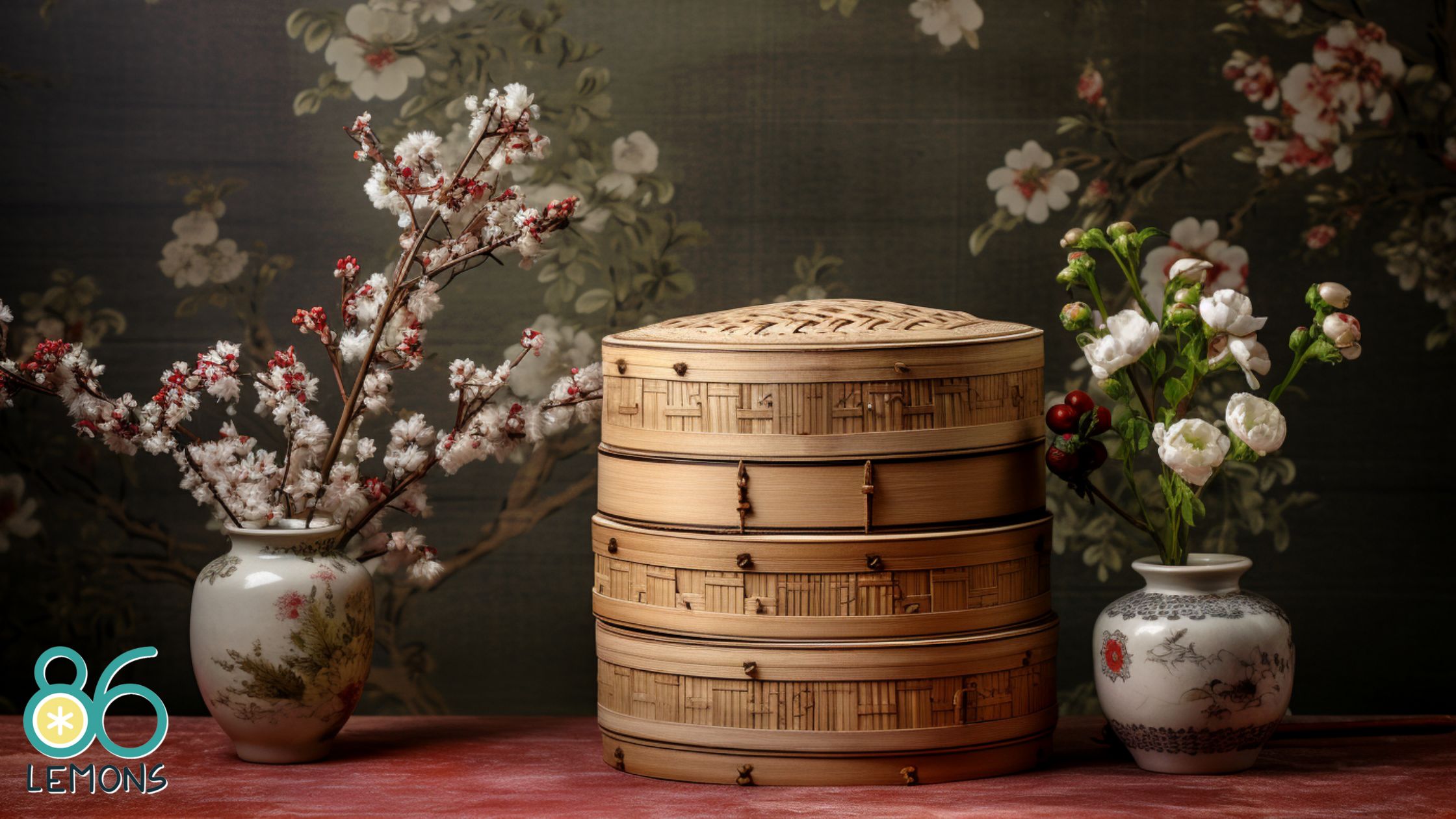Discovering the dishes you can create with a bamboo steamer can transform your culinary routine. It is a healthier cooking method since it eliminates the need for oil and retains the food’s natural flavors and nutrients.
Whether you’re a seasoned chef or a home cook, expanding your steaming repertoire with a bamboo steamer can lead to delicious mealtime revelations. The key to perfect steaming lies in your tools and techniques; choosing the best bamboo steamer basket is a significant first step in mastering this ancient cooking method.
Getting your bamboo steamer ready for action involves simple yet essential preparations. Water measurements, stacking techniques, and understanding the cooking times for different ingredients all play a part in steaming.
From fundamental recipes to gourmet specialties, the best bamboo steamer recipes will satisfy your every craving. These experiences await as you dive into the world of bamboo steamer cooking.
Key Takeaways
- A bamboo steamer offers a healthier cooking alternative that preserves food’s natural taste and nutrition.
- Proper preparation and choosing the correct steamer are essential for effective steaming and expanding your meal options.
- Bamboo steamers are versatile, perfect for cooking various dishes, from appetizers to main courses.
Choosing the Right Bamboo Steamer
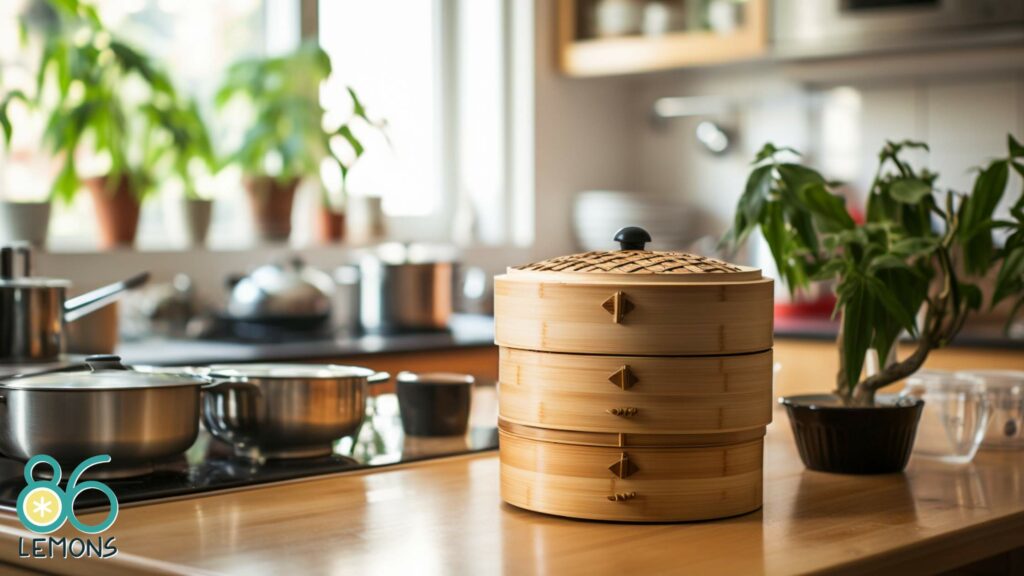
When you’re ready to steam your favorite veggies or dumplings, picking the right bamboo steamer is crucial for the best results. It’s all about the size, layers, and build quality that’ll perfectly suit your cooking needs.
Understanding Steamer Sizes and Layers
The size of your bamboo steamer should match the vessel you’re cooking with, like a carbon steel wok or a pot. Choose a steamer that’s just the right size—not too large to handle or too small for your portions.
Bamboo steamer baskets come in various diameters, typically 6 inches to 12 inches. The standard size is around 10 inches, ideal for most home cooking scenarios.
When it comes to layers, more is better if you plan to steam multiple items simultaneously. Most steamers come with two or three tiers, allowing you to separate different dishes while using the same steam source.
Material and Quality Considerations
A quality bamboo steamer is made from durable bamboo slats and grass. Check the construction; tightly packed slats and a snug-fitting lid are promising signs of craftsmanship.
It should feel sturdy but light. The materials should be natural and free of chemicals, as these could affect your food’s taste and safety.
A fine bamboo mesh indicates attention to detail and can hold smaller food items without the risk of them falling through. Although bamboo is naturally mold and bacteria-resistant, ensure your steamer doesn’t show signs of splintering or cracking, which could harbor unwanted microbes.
Preparing for Steaming
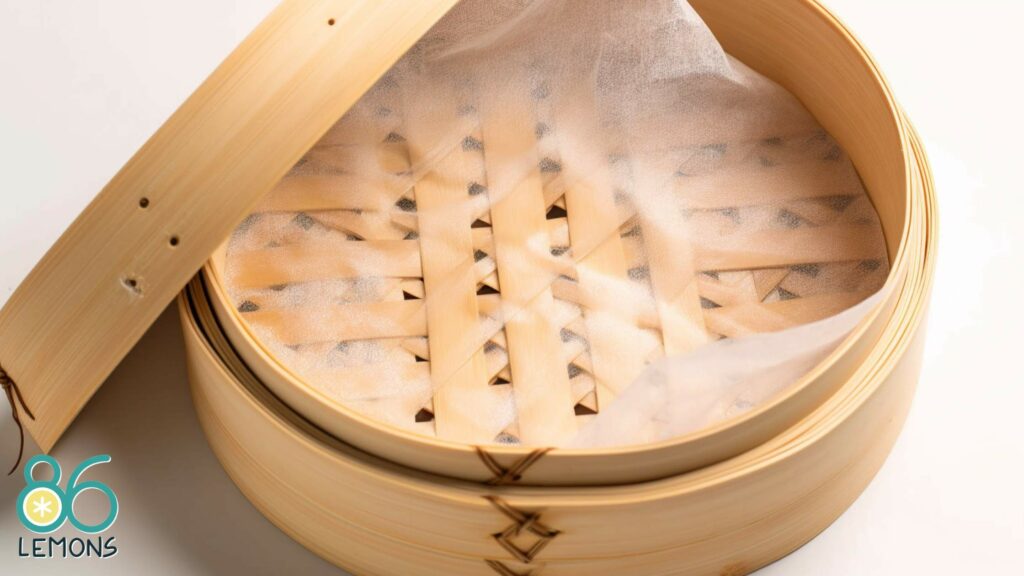
Before getting started, ensure you’ve got everything you need. The right setup and a little know-how about managing water levels and condensation are crucial for steaming success.
Pre-Steaming Checklist
- Choosing Your Pot or Wok: First, you will need a pot or a wok that your bamboo steamer fits snugly into. Your pot should be broad and deep enough to allow water space without touching the steamer’s bottom. Check out our list of the best cast iron woks for your kitchen.
- Water: Fill the pot with about an inch of water. Ensure it’s not too high to submerge the steamer’s bottom.
- Lining with Leaves: To keep your food from sticking, line the steamer’s bottom with cabbage or lettuce leaves–they’re a neat natural barrier.
- Perforated Paper: Alternatively, you could use perforated parchment paper cut to fit the steamer layers. This prevents sticking and makes clean-up a breeze.
- Oil: While not always necessary, a light oil brush on the steamer layers can help prevent sticking.
Managing Water and Condensation
- Keep an Eye on the Water Level: The water level can drop during steaming, so keep extra hot water ready to top it up as needed without losing steam or temperature.
- Lid Woes: Condensation builds under the lid, so when you lift it, tilt it away from you and your food to avoid water dripping onto your dish.
Steam can scald, so always be careful opening that steamer lid. Happy steaming!
Fundamental Bamboo Steamer Recipes
Diving into using a bamboo steamer will elevate your home cooking. You’ll master the foundation recipes like fluffy rice, vibrant vegetables, and pillowy buns.
Steaming Perfect Rice
To steam fluffy and tender rice, start with 1 cup soaked for at least 30 minutes before draining. Line your bamboo steamer with parchment paper or cabbage leaves to prevent sticking.
Spread your soaked rice evenly and steam for about 20 minutes. The key is to allow the sticky rice to become tender without becoming mushy.
Vegetable Steaming Techniques
For vegetables that are bright and crisp, timing is everything. Thinly sliced carrots or bell peppers take 2-3 minutes, while broccoli or bok choy take roughly 5 minutes.
Always preheat your bamboo steamer so the veggies cook quickly, retaining their nutrients and colors. Incorporate a dash of sesame oil or its substitutes after steaming for enhanced flavor.
Steamed Buns 101
To make irresistible steamed or bao buns, prepare a dough with flour, water, yeast, and sugar. After the dough rises, form small balls, flatten them, and spoon in your chosen filling—think dried mushroom or tofu for a vegan twist.
Steam for about 12 minutes until they’re puffy and cooked through. Remember, the bun’s texture should be soft but not break apart.
Specialty Dishes and Occasions
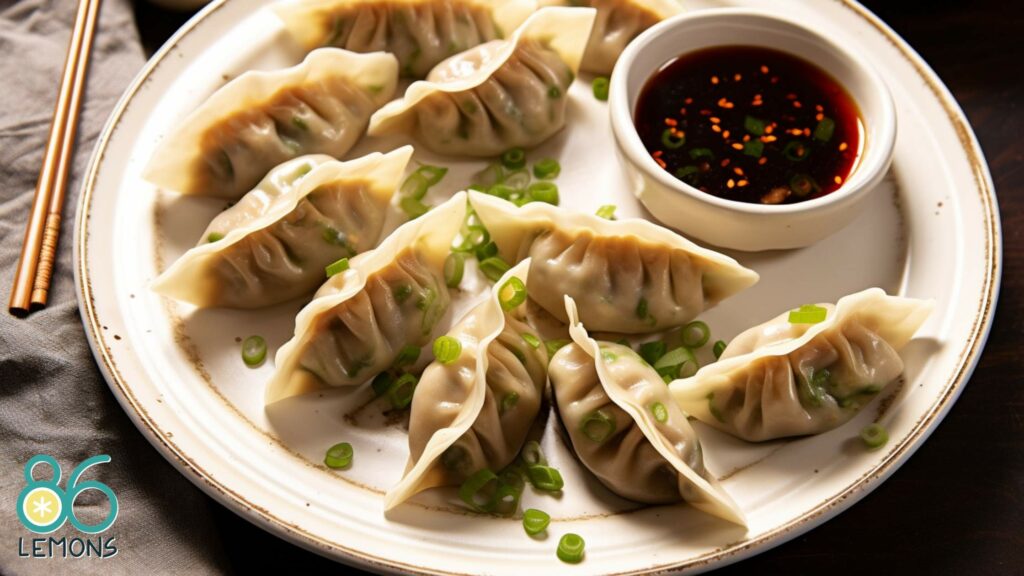
Whether celebrating Chinese New Year or just looking for a sweet twist to end your meal, a bamboo steamer can be your go-to kitchen tool. Dishes can range from traditional favorites to modern vegan alternatives that are just as delightful.
Bamboo Steaming for Chinese New Year
Nothing beats the traditional dim sum experience at home for your Chinese New Year celebration. You can create your spread with Vegan Teochew Crystal Dumplings, packed with umami from mushrooms and other veggies.
You can also try making delicate and savory Steamed Bao (Gua Bao) with mushrooms and crunchy pickled vegetables instead of pork. These are delicious, symbolize prosperity, and are perfect for ringing in the new year.
Sweet Endings: Steamed Desserts
Finish off with sweet treats like Puto Bumbong, a Filipino purple yam cake you can make vegan-friendly by skipping the traditional butter topping and opting for a sprinkle of sweetened coconut.
Explore the versatility of your steamer with creative cake and bread recipes. A simple recipe might be a steamed tofu dessert drizzled with a light ginger-soy sauce blend, sweetened with a hint of sugar for balance.
Remember, with steaming, it’s all about maintaining the natural flavors and delicate textures – no need for heavy sauces or intense spices. Just let the steam and your bamboo steamer work their magic!
Healthy Bamboo Steaming Alternatives

Bamboo steamers are your go-to tool when you’re looking to mix up your meal prep with something delicious and nutritious. They’re fantastic for locking in flavor without adding fat or calories.
Vegan and Vegetarian Options
You’re in luck if you’re aiming for plant-based perfection. Bamboo steamers are ideal for cooking various vegan and vegetarian dishes. Give Steamed Vegetable Dumplings a try; they’re packed with your choice of minced veggies wrapped in a tender dough.
Want something with a bit more bite? Stuffed Shiitake Mushrooms with a medley of veggies and nuts burst with umami and can be steamed to juicy goodness.
Lean and Green: Steaming Vegetables
Get your greens on with minimal effort by steaming them in your bamboo steamer. Asparagus spears turn out tender-crisp with a beautiful bright green color—just a couple of minutes, and they’re ready.
Or, if you’re looking to boost your meal with various vitamins and minerals, make a vibrant veggie platter of broccoli, bell peppers, and carrots for a colorful and crunch-packed side. Add them to your salad, like I made in this quinoa kale bowl.
Remember, steamed eggs can also be part of a healthy diet, but ensure the ingredients for your toppings or fillings align with vegan standards if that’s your dietary preference.
Care and Maintenance of Your Steamer
Taking good care of your bamboo steamer is essential for its longevity and your satisfaction. It boils down to regular cleaning and a few golden rules to avoid damage.
Cleaning Your Bamboo Steamer
First, you want to clean your bamboo steamer well after each use. Start with brushing off any food remnants; then grab some warm, soapy water and wipe it down with a soft sponge.
Never submerge your bamboo steamer in water, as it can cause the bamboo to swell and warp. A gentle scrub will do for stuck-on leftovers, but remember that bamboo is durable yet delicate.
Longevity Tips for Bamboo Steamers
To keep your steamer in the best shape:
- Avoid the microwave. Bamboo doesn’t play well with microwaves, considering it can dry out and crack.
- Dry properly before storage. Always air dry your steamer before tucking it away to prevent mold.
- Use barriers. Lining the steamer with parchment paper, cabbage leaves, or banana leaves can prevent sticking and make cleaning up a breeze.
- Store in a cool, dry place. Your kitchen cabinet is a good spot. Make sure it’s moisture-free.
- No metal utensils. Stick to wooden or silicone utensils to avoid scraping or piercing the bamboo.
By following these steps, your bamboo steamer will be ready for action whenever you are, all while staying in top-notch condition.
Expanding Your Steaming Repertoire
Investing time in mastering the bamboo steamer opens up a world of diverse flavors and recipes, including classic Chinese dishes and innovative homemade creations.
Exploring International Steamed Specialties
When you venture into international steamed specialties, you’re looking at a treasure trove of Chinese cuisine that includes delights like Chinese potstickers dough wraps filled with juicy plant-based fillings. Imagine biting into your very own batch of pillowy homemade pot stickers.
Don’t forget the light, fluffy, and irresistible steamed bao, and these soft buns can be stuffed with a variety of sweet or savory vegan fillings. Then, explore beyond Chinese borders to the Philippines for a taste of puto—adorable, steamed rice cakes that are a joy to make and eat.
Crafting Your Steamer Recipes
Diving into crafting your steamer recipes gives you the chance to be creative. Start with a solid base recipe, like a simple dough for bao or a basic potsticker mixture.
From there, tailor the ingredients to suit your taste. You can fill your creations with vegan fillings like seasoned tofu, mixed vegetables, or sweet bean pastes. You can also add some protein substitutes like seitan or tempeh.
Experiment with seasonings—soy sauce, five-spice, or lemongrass—for a personal touch. The key to success is carefully balancing flavors and using fresh, quality ingredients. Don’t hesitate to draw inspiration from existing recipes as a launchpad for your culinary adventures.
Tips and Tricks for the Ultimate Steaming Experience
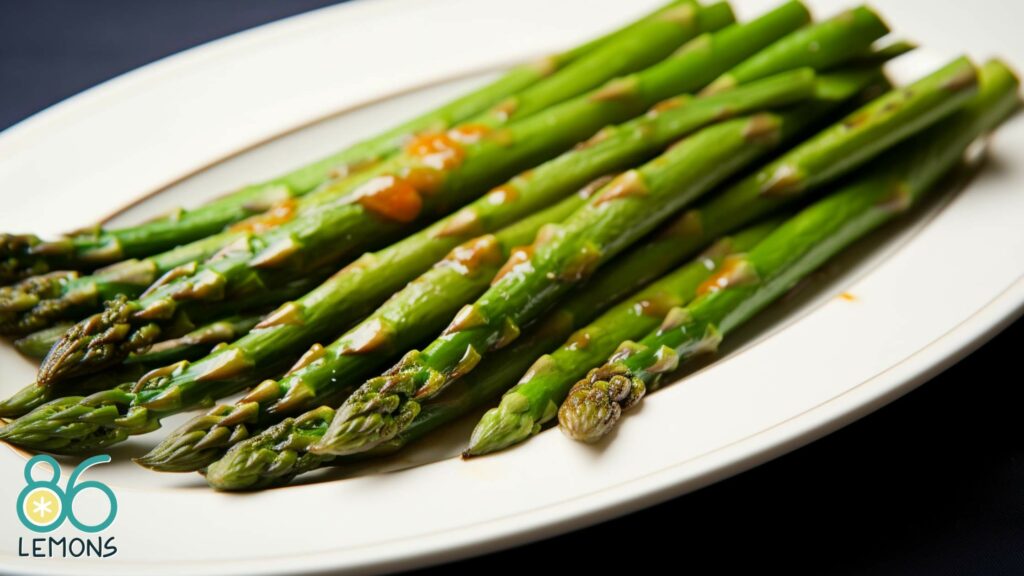
Ready to elevate your bamboo steamer game? With these focused tactics, you’re set to sidestep common mishaps and get creative in the kitchen.
Preventing Scorching and Overcooking
Scorching can be the downfall of many potentially delicious dishes, especially when steaming something delicate. To safeguard against this, line your bamboo steamer basket with cabbage, lettuce, or banana leaves.
Not only does this prevent sticking, but it also infuses your dish with subtle flavors. Monitor cooking time meticulously for moisture-sensitive items to avoid overcooking — an attentive eye ensures perfect texture every time.
Using the Bamboo Steamer in Creative Ways
Ditch the monotony and use your bamboo steamer for more than your usual fare. Try steaming slices of seitan, positioning them over a layer of aromatic spices on parchment paper for an evenly cooked, juicy entree bursting with flavor.
As for materials, sesame oil can be brushed on the steamer’s edges, subtly enhancing the dish’s nutty essence. Flex your culinary creativity and watch your bamboo steamer become the most versatile tool in your kitchen.

